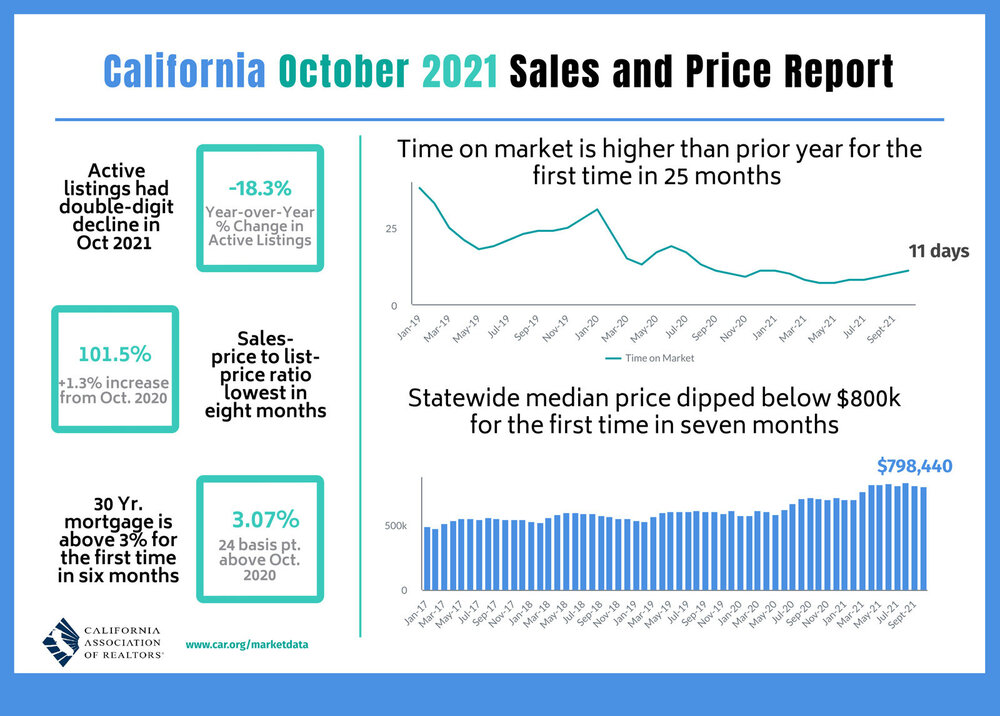Residential Real Estate News

California Median Home Prices up 12 Percent Annually in October
Residential News » Santa Barbara Edition | By Michael Gerrity | November 19, 2021 8:02 AM ET
California's median home price now sits at $798,440
California Realtors are reporting this week that closed escrow sales of existing, single-family detached homes in California totaled a seasonally adjusted annualized rate of 434,170 in October, 2021.
The statewide annualized sales figure represents what would be the total number of homes sold during 2021 if sales maintained the October pace throughout the year. It is adjusted to account for seasonal factors that typically influence home sales.
October's sales pace dipped 0.9 percent on a monthly basis from 438,190 in September and was down 10.4 percent from a year ago, when 484,510 homes were sold on an annualized basis. Despite the fourth straight year-over-year sales decrease, statewide home sales maintained a 13.4 percent increase on a year-to-date basis.
"As the housing market moves from 'frenzied' to 'less frenzied' and price growth comes back to earth, fewer homes are selling above asking price and bidding wars are less prevalent, so more buyers who pushed pause earlier this year will be able to take advantage of still-cheap financing," said 2022 C.A.R. President Otto Catrina. "With their median price being 30 percent less than that of a single-family home, condominiums and townhomes have been selling particularly well as they are a more affordable option to buyers with a smaller budget."
California home prices continued to level off as the market moved further into the off-season, dipping below the $800,000 benchmark for the first time in seven months. At $798,440 in October, the statewide median price was down 1.3 percent from September's $808,890 and was up 12.3 percent from the $711,300 recorded in October 2020. The month-to-month price decline was the second in a row, and the price drop from September was on par with the long run average of -1.5 percent recorded between September and October in the past 42 years.
"Despite a slowdown in sales from last year's robust fall season, the California housing market continues to stabilize and is outperforming the pre-pandemic levels observed in 2017, 2018, and 2019," C.A.R. Vice President and Chief Economist Jordan Levine said. "Slower sales activity suggests that the market is returning to its typical seasonal pattern and further market normalization can be expected in the upcoming months. While the market is showing signs of cooling off in recent months, 2021 continues to outpace last year's sale level so far and is expected to post a gain at year-end."
Key points from C.A.R.'s October 2021 report include:
- At the regional level, all five regions recorded a decline in sales on a year-over-year basis in October, with three regions dropping by double-digits. Wildfires continued to have a negative impact on market conditions in the Far North as sales in the region dropped 23.4 percent from a year ago. The decline will likely continue as the recovery process from wildfires could take months if not years. The Central Coast had the next biggest sales drop, with all counties within the region falling at least 13.8 percent from the prior year. Sales in Southern California also dipped by double-digits in October, with Orange, Riverside, and San Bernardino counties each dropping 10 percent or more. Central Valley (-9.1 percent) and San Francisco Bay Area (-7.3 percent) also posted sales declines from last year, but the declines were relatively small when compared to other regions.
- More than four out of five counties -- 43 of 51 -- tracked by C.A.R. recorded a year-over-year decrease in closed sales in October, with 29 counties declining by more than 10 percent. Mariposa experienced the biggest sales decline from last year at -52.9 percent, followed by Plumas (-50.7 percent), and Tehama (-48.2 percent). Two of these counties were threatened by wildfires in late summer, which negatively affected housing demand. Counties recording a year-over-year sales dip had an average decrease of -19.4 percent in October. Seven counties experienced a year-over-year sales growth compared to 10 counties in September. Lassen had the largest sales gain (50.7 percent) from a year ago, followed by Yuba (28.9 percent), and Madera (20.2 percent).
- Almost all California counties experienced year-over-year price growth, as 49 out of 51 counties tracked by C.A.R. showed a gain in their median prices from last year. Forty of them, in fact, increased more than 10 percent from last October. Madera had the largest price growth at 30.4 percent, followed by San Mateo (25.6 percent), Plumas (22.1 percent), and Sutter (22.1 percent).Santa Barbara and Mono were the only two counties that posted a drop, declining 19.3 percent and 0.5 percent, respectively from last October. Eight counties set new record high median prices in October, as compared to seven counties the prior month.
- Market competitiveness remained elevated in October but was less heated than a few months ago. While the statewide median sales-price-to-list-price ratio remained above 100 percent in October, it was the lowest level in eight months. Nearly two-thirds of homes (60.2 percent) still sold above asking price in the latest monthly report, but it was at the lowest level since February 2021.
- California's Unsold Inventory Index (UII) dipped on a month-to-month basis for the first time in four months, as active listings fell 18.3 percent from last year. October's UII was 1.8 months in October and 2.0 months in October 2020. The index indicates the number of months it would take to sell the supply of homes on the market at the current rate of sales.
- The median number of days it took to sell a California single-family home inched up to 11 days in October, up from 10 days in September and 10 days in October 2020. The uptick was the first in more than two years.
- C.A.R.'s statewide sales-price-to-list-price ratio was 101.5 percent in October 2021 and 100.2 percent in October 2020.
- The statewide average price per square foot for an existing single-family home remained elevated. October's price per square foot was $389, up from $326 in October a year ago.
- The 30-year, fixed-mortgage interest rate averaged 3.07 percent in October, up from 2.83 percent in October 2020, according to Freddie Mac. The five-year, adjustable mortgage interest rate was an average of 2.54 percent, compared to 2.89 percent in October 2020.
Sign Up Free | The WPJ Weekly Newsletter
Relevant real estate news.
Actionable market intelligence.
Right to your inbox every week.
Real Estate Listings Showcase
Related News Stories
Residential Real Estate Headlines
- Las Vegas Area Home Prices Uptick 4.3 Percent Annually in March
- Single-Family Rent Growth in U.S. Trends Upward in 2025
- U.S. Mortgage Rates Tick Down Post Trump Tariffs Commencement
- President Trump's 'Liberation Day' Tariffs Potential Impact on the U.S. Housing and Mortgage Markets
- Baby Boomers Biggest Cohort of U.S. Home Buyers in 2025 as Millennials Decline
- U.S. Monthly Housing Payments Hit Record High in 2025
- U.S. Pending Home Sales Uptick in February
- Global Prime Residential Rent Slowdown Continued in Late 2024
- Ireland Home Price Inflation Hits 8 Year High in Early 2025
- Existing Home Sales in America Uptick in February
- Great Miami Area Residential Sales Decline 15 Percent Annually in February
- Mortgage Rates Uptick in Mid-March, Ending 9-Week Decline in U.S.
- World Property Ventures Builds the Future of Real Estate with New Funding Round
- U.S. Builder Sentiment Declines Amid Economic Uncertainty and Rising Costs
- Black Homeownership Rates in U.S. Enjoy Largest Annual Increase of All Racial Groups
- Wealthy Renters Are Taking Over More of the U.S. Rental Market
- If U.S. Congress Does Not Extend NFIP Soon, Thousands of Daily Home Closings Impacted
- U.S. Mortgage Applications Spike 11 Percent in Early March
- Greater Palm Beach Area Residential Sales Rise in Early 2025
- New Apartments in U.S. Are Leasing at Slowest Pace on Record
- U.S. Mortgage Rates Drop to 4 Month Low in March
- Overall U.S. Mortgage Delinquency Rates Dip in December
- New Tariffs on Canada, Mexico to Impact U.S. Homebuilder Input Costs
- Monaco's Property Market: A Tale of Two Cities
- U.S. Home Purchase Cancellations Surge, 1 in 7 Sales Getting Canceled
- U.S. Pending Home Sales Hit Historic Low in Early 2025
- Greater Miami Area Residential Sales Dip in January
- Governor DeSantis Supports Ending Property Taxes in Florida
- WPV Aims to Become the Berkshire Hathaway of Real Estate Tech
- U.S. Home Sales Slump Continues in January
- Average Americans Spend 38 Percent of Monthly Income on Mortgage Payments
- Switzerland's Safe-Haven Appeal Grows with World's Wealthy Homebuyers
- U.S. Builder Confidence Rapidly Declines in February
- Las Vegas Home Sales Rise 6.7 Percent Annually in January, Condo Sales Dip
- Homebuyer Demand in America Drops to 5-Year Low in Early 2025
- Ownership More Affordable Than Renting in Most U.S. Markets
- The World's First Global Listings Service Launches, Called a GLS
- Home Prices Continue to Rise in 89 Percent of U.S. Metros in Late 2024
- Global Luxury Residential Prices Showed Gradual Improvement in Late 2024
- U.S. Construction Hiring Rate Drops to Lowest Levels in 5 Years






